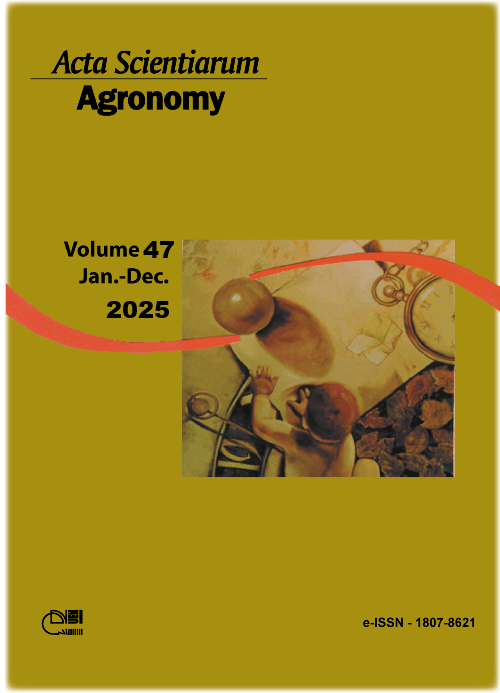High-density planting effects on maxixe production
Abstract
Maxixe is a vegetable with high nutritional value, yet there is limited information on crop management practices, particularly regarding row and plant spacing. This study aimed to evaluate maxixe production under high planting densities in two locations, Montes Claros and Mocambinho, Minas Gerais State, Brazil. The experiment was designed as a 2 x 2 x 4 factorial scheme, with two locations, four plant numbers per hole, and four hole densities, using the cultivar Maxixe do Norte. A randomized block design with four replications was employed. The variables analyzed included the number of fruits per plant and per hectare, pericarp thickness, fresh and dry fruit mass, and overall productivity. Data were subjected to multiple regression analysis, and curve comparisons were made using the model identity test. No significant difference was observed in fruit yield between the two locations; the highest yield recorded was 56,489.63 kg ha-1 at the highest planting densities. Increased planting density resulted in higher yields in weight and number of fruits per area, but fewer fruits per plant and reduced fresh and dry fruit mass at higher densities. Therefore, considering production per area and plant, an intermediate planting density is most appropriate, as it enhances yield without compromising fruit quality. In short, the recommended density for optimal fruit production is 33,000 holes per hectare, with three plants per hole.
Downloads
References
Anderson, J. T., Wagner, M. R., Rushworth, C. A., Prasad, K. V. S. K., & Mitchell-Olds, T. (2014). The evolution of quantitative traits in complex environments. Heredity, 112, 4-12. https://doi.org/10.1038/hdy.2013.33
Dalvi, N. V., Salvi, B. R., Chavan, A. S., & Kandalkar, M. P. (2010). High density planting in mango cv. Alphonso. Journal of Horticultural Sciences, 5(2), 117-119. https://doi.org/10.24154/jhs.v5i2.457
Filgueira, F. A. R. (2008). Novo manual de olericultura: Agrotecnologia moderna na produção e comercialização de hortaliças (3. ed.). Editora UFV.
Gomes, R. F., Santos, L. S., Marin, M. V., Diniz, G. M., Rabelo, H. O., & Braz, L. T. (2017). Effect of spacing on mini watermelon hybrids grown in a protected environment. Australian Journal of Crop Science, 11(5), 522-527. https://doi.org/10.21475/ajcs.17.11.05.p313
Maboko, M. M., & Du Plooy, C. P. (2013). High-plant density planting of basil (Ocimum basilicum) during summer/fall growth season improves yield in a closed hydroponic system. Acta Agriculturae Scandinavica, Section B-Soil & Plant Science, 63(8), 748-752. https://doi.org/10.1080/09064710.2013.861921
Mendes, A. H. L., Almeida. É. J. N., Moreiran, L. F., Mendes, L. G., & Farias, V. L. (2022). Impact of cooking on the bioactive compounds and antioxidant activity of gherkin (Cucumis anguria L.). Journal of Environmental Analysis and Progress, 7(1), 33-40. https://doi.org/10.24221/jeap.7.01.2022.3889.033-040
Oliveira, A. P., Silva, J. A., Oliveira, A. N. P., Silva, D. F., Santos, R. R., & Silva, N. V. (2010). Produção do maxixeiro em função de espaçamentos entre fileiras e entre plantas. Horticultura Brasileira, 28(3), 344-347. https://doi.org/10.1590/S0102-05362010000300017
Piepho, H. P. (2019). A coefficient of determination (R2) for generalized linear mixed models. Biometrical Journal, 61(4), 860-872. https://doi.org/10.1002/bimj.201800270
R Core Team. (2022). R: A language and environment for statistical computing. R Foundation for Statistical Computing. https://www.R-project.org/
Reis, R. D. G. E, Silva, H. P. D., Neves, J. M. G., & Guimarães, R. M. (2013). Physiological quality of osmoprimed gherkin seeds. Journal of Seed Science, 35(3), 368-373.
Resende, G. M., Borges, R. M. E., & Gonçalves, N. P. S. (2013). Produtividade da cultura da abóbora em diferentes densidades de plantio no Vale do São Francisco. Horticultura Brasileira, 31(3), 504-508. https://doi.org/10.1590/S0102-05362013000300027
Reyes, I. D. P., Teles, S. P., Tavares, A. T., Carline, J. V. G., Nascimento, I. R., & Queiroz Luz, J. O. S. (2022). Combining ability and gene action in the expression traits in maxixe. Revista Caatinga, 35(2), 498-504. https://doi.org/10.1590/1983-21252022v35n225rc
Saju, S. M., & Thavaprakaash, N. (2020). Influence of high density planting under modified system of rice intensification on growth, root characteristics and yield of rice in the western zone of tamil nadu. Madras Agricultural Journal, 107(1-3), 25-29. https://doi.org/10.29321/MAJ.2020.000339
Sheha, A. M., Allam, H. M., Abdelkader, A. F., & Mohamed, M. K. (2022). Effect of relaying intercropping onion transplanting dates on faba bean under different plant densities. Journal of Plant Production, 13(7), 287-296. https://doi.org/10.21608/JPP.2022.143445.1126
Silva, A. W. B., Silva, B. D. N. D., Costa, A. L. D., Cézar, K. C., Gomes, L. A. A., & Oliveira, C. L. D. (2021). Planting density and yield of sweet pepper grown in an organic system. Pesquisa Agropecuária Brasileira, 56, 1-7. https://doi.org/10.1590/S1678-3921.pab2021.v56.02470
Sun, Y., Zang, H., Splettstöber, T., Kumar, A., Xu, X., Kuzyakov, Y., Pausch, J. (2021). Plant intraspecific competition and growth stage alter carbon and nitrogen mineralization in the rhizosphere. Plant, Cell & Environment, 44(4), 1231-1242. https://doi.org/10.1111/pce.13945
Zhang, Y., Xu, Z., Li, J., & Wang, R. (2021). Optimum planting density improves resource use efficiency and yield stability of rainfed maize in semiarid climate. Frontiers in Plant Science, 12, 1-10. https://doi.org/10.3389/fpls.2021.752606
Copyright (c) 2025 Guilherme Brandão Santos, Cândido Alves da Costa, Delacyr da Silva Brandão Junior, Nermy Ribeiro Valadares, Raniell Inácio Leandro (Autor)

This work is licensed under a Creative Commons Attribution 4.0 International License.
DECLARATION OF ORIGINALITY AND COPYRIGHTS
I Declare that current article is original and has not been submitted for publication, in part or in whole, to any other national or international journal.
The copyrights belong exclusively to the authors. Published content is licensed under Creative Commons Attribution 4.0 (CC BY 4.0) guidelines, which allows sharing (copy and distribution of the material in any medium or format) and adaptation (remix, transform, and build upon the material) for any purpose, even commercially, under the terms of attribution.
Funding data
-
Coordenação de Aperfeiçoamento de Pessoal de Nível Superior
Grant numbers 001




















































